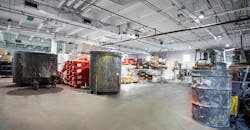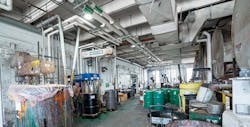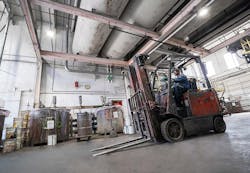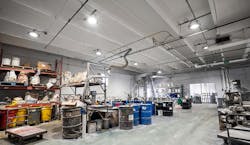Now a fourth-generation family-owned business, Diamond Vogel is the midwestern leader in paints and coatings for architectural, industrial, wood, farm and fleet, traffic and aerosol applications. With a commitment to innovation that’s kept the company thriving since 1926, the company operates seven manufacturing facilities and 63 service centers.
At its Tulsa, OK paint mixing facility, the company produces thousands of gallons of paint and coatings, combining powdered pigments, proprietary coating formulas, and other raw materials to produce its long-lasting, high-quality products.
Conventional Fixtures Couldn’t Cut It
Because of the potential for airborne particles and fumes, the facility is a Class I Div 2 hazardous environment, which imposes strict requirements on the type of fixtures that could be used safely inside. Not only must they be hazardous certified, but heat is also a concern, as temperatures routinely reach 110°F under the scorching Midwestern sun. At those high temperatures, virtually any conventional fixture would be hard-pressed to survive.
Production supervisor Alton Wells not only runs the day to day operations, but he’s also the de facto maintenance man for the 27,500 square foot facility. For most of the last 19 years of his career, the Tulsa facility was lit with banks of 300W incandescent lights—roughly 10 banks of 6 fixtures each. Under the grueling heat, the fixtures failed frequently, not to mention emitted poor quality light when they did work.
This was a serious concern, considering that poor lighting is the leading cause of slip, trip, and fall incidents, which are some of the most common causes of workplace injuries. And, data shows that improving overall illumination in a facility can reduce accident rates by as much as 60%. While accidents weren’t a major problem for Diamond Vogel, Wells recognized the opportunity to lower the risk even further, while also reducing the maintenance demand.
“We dealt with a lot of shadows because of the poor quality of the incandescents, which made it difficult to make precise measurements of raw materials in our manufacturing process. It was hard to see the markings on the containers,” Wells said. “Plus, lights were constantly popping off in the summer months due to the heat, and with 12 to 15 bolts holding each fixture together, it took a long time just to change one light bulb.”
Complicating matters, most of the lights were positioned directly over raw material storage—about 25 ft high. That meant accessing fixtures with burned out bulbs was practically impossible most of the time, leaving no choice but to wait until so many lights were out that it forced Wells to bite the bullet and replace lights. In the summer, this could become a monthly routine.
Egress lighting was also lacking. The facility did have the OSHA-required emergency lighting and exit signs over each exterior door but getting safely to that door could be a challenge. With power outages a relatively frequent occurrence, thanks to notoriously powerful Oklahoma thunderstorms, safe backup lighting was a concern. Wells had installed backup battery lights over three doors, but this required monthly testing of each fixture and replacement of the very expensive batteries in each system every 3 years.
Dialight Exceeds Expectations
In the quest to find better lighting, Wells initially found a 65W CFL bulb that would fit into the existing fixtures. But, even these only lasted about two months. Although that was twice as long as the incandescents, the bulbs were getting progressively harder to find. The CFLs also failed to deliver the light quality Wells was hoping for in the area under the mezzanine.
Spurred by a suggestion from a colleague, Wells decided to look into LED fixtures, inviting Dialight and a couple of other companies in for a light study. Dialight was the only one to bring in an actual fixture to demonstrate the color rendering, clarity, and brightness their products were capable of.
“When I saw the color of the light, I was really impressed,” Wells said. “Plus, no one was offering the same kind of warranty. Between the quality of light, how long they’d last and the warranty, it was an easy decision.”
Wells says in addition to the product quality, Dialight also outshone the competition on service, going above and beyond to make sure he was pleased. Initially planning to buy linear fixtures, Wells says the Dialight team convinced him that a conventional High Bay was the better option to meet his needs based on light studies and hard data. “It wasn’t that they were trying to sell me a more expensive product. They wanted to sell me a product that they knew would work better,” Wells said. “They were looking out for my best interests.”
By the time Wells made the purchase, Dialight’s manufacturing process had changed slightly, which meant the lights that arrived had a slightly different color than the one he’d tested. Determined to resolve the issue, Dialight went back to the factory and custom configured a fixture to match Wells’ expectations.
“It wasn’t like I was buying 1,000 fixtures, but their willingness to go above and beyond really stood out,” Wells said. “I knew right then that, as we went forward in our upgrade, Dialight would be the one we go with. They did what they promised and I trusted them. A lot of companies don’t do that, and that went a long way with me.”
The Dialight Difference is Clear
The Dialight SafeSite High Bays have made a tremendous difference in improving color clarity, brightness, safety and even workers’ mood inside the facility. With over fifty 11,000 lumen, six 14,000 lumen and six 26,000 lumen CIass I, Div. 2 SafeSite High Bays now in place, Wells says it’s “like night and day” inside the facility. Even better, Diamond Vogel was able to reduce their fixture count by about 10 lights.
“So, we’ve lit the place with fewer fixtures than we originally had, and we’ve got easily four-times the light,” Wells said. “The difference is amazing. It’s better by leaps and bounds, and it’s helping us to be more efficient because we can see so much better.”
The elimination of harsh shadows allows employees to measure raw materials more accurately for precision formulation of their products, and the outstanding color clarity improves quality control and R&D. Plus, it’s safer: LED lighting has proven to improve trip hazard detection by 23.7% and reduce glare by roughly 50%. In addition, the white light of LEDs encourages alertness and reduces fatigue by a factor of 5X, helping employees to feel more alert and energetic on the job.
“Of course, since we could see better, it made those areas that could use a little cleaning or sprucing up a bit more obvious,” Wells quipped. “And so now we’re keeping things a lot neater, painting more and it just makes the whole place look nicer.”
At the same time, Wells says it’s made a huge difference for employees. “I’ve already noticed an increase in the mood of everyone on the floor. Before, it was like working in a cave with a flashlight,” he said. “When the contractor started turning the new lights on as they were installed, everybody said, ‘Wow!’ and they couldn’t believe the difference. I show them off to everyone who comes in here from corporate. I just can’t help myself.”
Because several of the fixtures Diamond Vogel chose included Dialight’s built-in DC battery backup system, this not only substantially improved egress and safety lighting, but also cut down on maintenance of the system. Now, the facility has 13 battery backup lights, instead of just three, all wired into a transfer switch and central DC power supply. That means multiple points of safety lighting, with just one point of maintenance. To conduct a test requires Wells to simply flip the transfer switch, look out and make sure the lights are on, then turn the system off—it now takes just seconds instead of half a day once a month.
“We are extremely pleased with the entire experience of working with Dialight,” Wells said. “A lot of companies will try to sell you something you don’t need, but Dialight really listened to my needs, understood their products and capabilities, and even though they pushed me in a different direction, it was for my benefit. And, the fact that they covered all of these products with a 10-year warranty, that is amazing to me.”
Installation Snapshot
- Paint mixing facility in Tulsa, OK
- Class I Div. 2 hazardous environment
- Incandescent lighting maintenance was an ongoing chore
- Poor light quality hindered productivity and quality control
- Installed 63 Dialight SafeSite High Bay fixtures and 6 linears
- Reduced fixture count by 10
- Dramatic improvement in visibility
- Improved employee mood and morale
- Provides safer emergency/egress lighting
To learn more about Dialight’s complete line of SafeSite and other industrial LED fixtures, visit www.dialight.com.
About the Author
Dialight
Dialight is the world leader in LED industrial lighting technology with over 1 million LED fixtures installed worldwide. Our story began in 1938 in Brooklyn, NY, where we produced instrument panel lights for aircraft. In 1971, just one year after the introduction of the LED, we launched our first LED product. Since then, we have revolutionized the use of LEDs and ONLY LEDs, to provide superior lighting for traffic control, indicators, structural towers and industrial work sites around the world.




